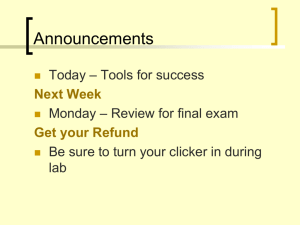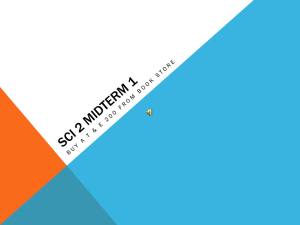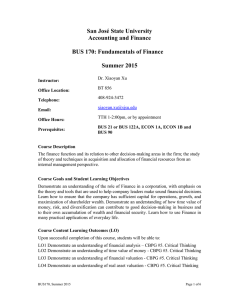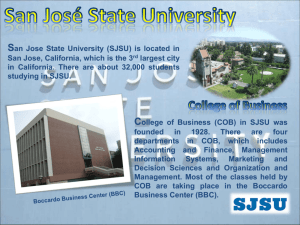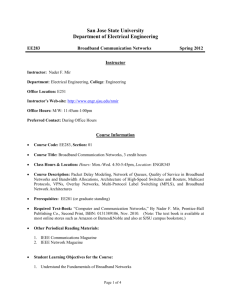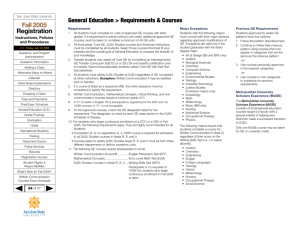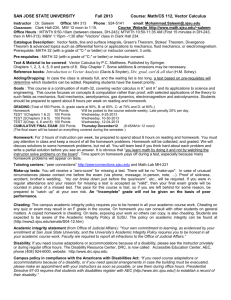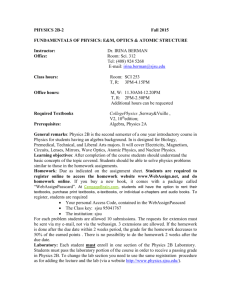Accessible Syllabus Template
advertisement
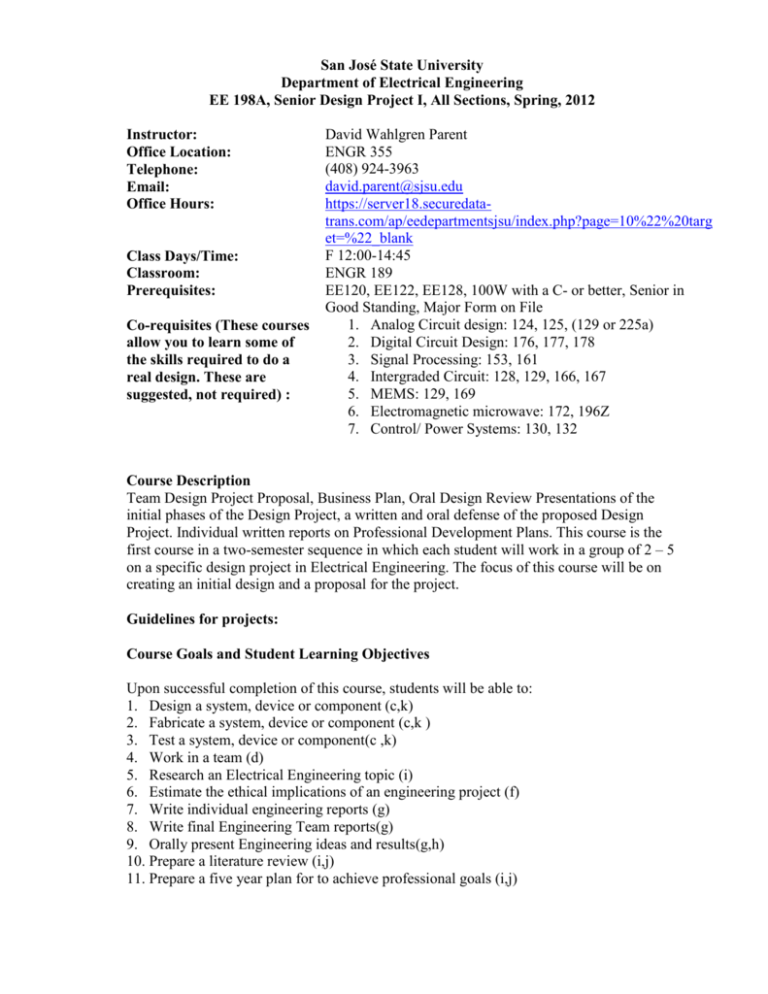
San José State University Department of Electrical Engineering EE 198A, Senior Design Project I, All Sections, Spring, 2012 Instructor: Office Location: Telephone: Email: Office Hours: Class Days/Time: Classroom: Prerequisites: Co-requisites (These courses allow you to learn some of the skills required to do a real design. These are suggested, not required) : David Wahlgren Parent ENGR 355 (408) 924-3963 david.parent@sjsu.edu https://server18.securedatatrans.com/ap/eedepartmentsjsu/index.php?page=10%22%20targ et=%22_blank F 12:00-14:45 ENGR 189 EE120, EE122, EE128, 100W with a C- or better, Senior in Good Standing, Major Form on File 1. Analog Circuit design: 124, 125, (129 or 225a) 2. Digital Circuit Design: 176, 177, 178 3. Signal Processing: 153, 161 4. Intergraded Circuit: 128, 129, 166, 167 5. MEMS: 129, 169 6. Electromagnetic microwave: 172, 196Z 7. Control/ Power Systems: 130, 132 Course Description Team Design Project Proposal, Business Plan, Oral Design Review Presentations of the initial phases of the Design Project, a written and oral defense of the proposed Design Project. Individual written reports on Professional Development Plans. This course is the first course in a two-semester sequence in which each student will work in a group of 2 – 5 on a specific design project in Electrical Engineering. The focus of this course will be on creating an initial design and a proposal for the project. Guidelines for projects: Course Goals and Student Learning Objectives Upon successful completion of this course, students will be able to: 1. Design a system, device or component (c,k) 2. Fabricate a system, device or component (c,k ) 3. Test a system, device or component(c ,k) 4. Work in a team (d) 5. Research an Electrical Engineering topic (i) 6. Estimate the ethical implications of an engineering project (f) 7. Write individual engineering reports (g) 8. Write final Engineering Team reports(g) 9. Orally present Engineering ideas and results(g,h) 10. Prepare a literature review (i,j) 11. Prepare a five year plan for to achieve professional goals (i,j) GE/SJSU Studies Learning Outcomes (LO), if applicable Upon successful completion of this course, students will be able to: LO2 Demonstrate the ability to apply the practice of Engineering in real-world problems. Course Content Learning Outcomes The students are able to apply knowledge and skills acquired in earlier coursework to identify, formulate, and propose a sound solution to an engineering problem (c,k) The students have an understanding of ethics, social implication of engineering, and the need for life-long-learning (i,f) The students can function in teams and can communicate effectively. (g) The students can describe and use industry standards (c) Topics: Engineering ethics. Social implications of Engineering. Team work and life-long learning Communication skills Career objectives and interviewing Industry standards ABET outcomes The letters in parentheses in the course learning objectives refer to ABET criterion 3 outcomes satisfied by the course. These are listed below as a reference: (a) An ability to apply knowledge of mathematics, science, and engineering (b) An ability to design and conduct experiments, as well as to analyze and interpret data (c) An ability to design a system, component, or process to meet desired needs (d) An ability to function on multi-disciplinary teams (e) An ability to identify, formulate, and solve engineering problems (f) An understanding of professional and ethical responsibility (g) An ability to communicate effectively (h) The broad education necessary to understand the impact of engineering solutions in a global and societal context (i) A recognition of the need for, and an ability to engage in life-long learning (j) A knowledge of contemporary issues (k) An ability to use the techniques, skills, and modern engineering tools necessary for engineering practice (l) Specialization in one or more technical specialties that meet the needs of companies (m) Knowledge of probability and statistics, including applications to electrical engineering (n) Knowledge of advanced mathematics, including differential and integral equations, linear algebra, complex variables, and discrete mathematics (o) Basic sciences, computer science, and engineering sciences necessary to analyze and design complex electrical and electronic devices, software, and systems containing hardware and software components Required Texts/Readings Textbook NA Other Readings Classroom Protocol Cell Phones: Students will turn their cell phones off or put them on vibrate mode while in class. They will not answer their phones in class. Students whose phones disrupt the course and do not stop when requested by the instructor will be referred to the Judicial Affairs Officer of the University. Computer Use: In the classroom, students are allowed to use computers only for class-related activities. These include activities such as taking notes on the lecture underway, following the lecture on Web-based PowerPoint slides that the instructor has posted, and finding Web sites to which the instructor directs students at the time of the lecture. Students who use their computers for other activities or who abuse the equipment in any way, at a minimum, will be asked to leave the class and will lose participation points for the day, and, at a maximum, will be referred to the Judicial Affairs Officer of the University for disrupting the course. (Such referral can lead to suspension from the University.) Students are urged to report to their instructors computer use that they regard as inappropriate (i.e., used for activities that are not class related). Academic Honesty: Faculty will make every reasonable effort to foster honest academic conduct in their courses. They will secure examinations and their answers so that students cannot have prior access to them and proctor examinations to prevent students from copying or exchanging information. They will be on the alert for plagiarism. Faculty will provide additional information, ideally on the green sheet, about other unacceptable procedures in class work and examinations. Students who are caught cheating will be reported to the Judicial Affairs Officer of the University, as prescribed by Academic Senate Policy S04-12. “You are responsible for understanding the policies and procedures about add/drops, academic renewal, withdrawal, etc. found at http://www2.sjsu.edu/senate/S04-12.pdf • • • Expectations about classroom behavior; see Academic Senate Policy S90-5 on Student Rights and Responsibilities. As appropriate to your particular class, a definition of plagiarism, such as that found on Judicial Affairs website at http://www2.sjsu.edu/senate/plagarismpolicies.htm “If you would like to include in your paper any material you have submitted, or plan to submit, for another class, please note that SJSU’s Academic Integrity policy Dropping and Adding Students are responsible for understanding the policies and procedures about add/drops, academic renewal, etc. Information on add/drops are available at http://info.sjsu.edu/webdbgen/narr/soc-fall/rec-298.html. Information about late drop is available at http://www.sjsu.edu/sac/advising/latedrops/policy/ . Students should be aware of the current deadlines and penalties for adding and dropping classes. Assignments and Grading Policy Outcome Assessment (Grading): 5% Seminar Attendance. You must attend: o Each 198A meeting o One session of EE198B final project presentations (on the “dead day” between the last day of class and the first day of exams. o Two Silicon Valley Leader Symposia in room 189, (every Thursday from 12 to 1pm for details go to http://www.engr.sjsu.edu/speakers/ ) You can make up the presentations with extra 198B or EE297/299 presentation sessions. You will have to submit one paragraph describing what you learned at each symposium. (Individual) 35% Written Final Proposal. Your proposal will be judged by your project advisor and one other EE faculty member. (Group)1 10% Business Plan – This Plan must be approved by the Coordinator and outside evaluators before the project may continue(Group) 20% Adviser Evaluation (Individual) 10% Where do I want to be in 5 years and how am I going to get there? (Individual) 20% Oral presentation. Your presentation will be judged by your project advisor, one other EE faculty member(Group) Students should take the skill audit exam for practice this semester! o Students must get an 80% on the in-class Skill Audit Exam to get a Go o Students must take the on-line Skill Audit Exam in order to take the in-class skill audit exam There are no I grades given for “running out of time”. All assignments will be turned in on “black board” All assignments will be graded according to the rubrics provided in “black board” Grading Percentage Breakdown 94% and above A 93% - 90% A89% - 87% B+ 86% - 84% B 83% - 80% B79% - 77% C+ 76% - 74% C 73% - 70% C69% - 67% D+ 66% - 64% D 63% - 60% Dbelow 60% F University Policies Academic integrity Students should know that the University’s Academic Integrity Policy is availabe at http://www.sa.sjsu.edu/download/judicial_affairs/Academic_Integrity_Policy_S07-2.pdf. 1 Note: You will not receive the group grade, if you have not participated in the group work. Your own commitment to learning, as evidenced by your enrollment at San Jose State University and the University’s integrity policy, require you to be honest in all your academic course work. Faculty members are required to report all infractions to the office of Student Conduct and Ethical Development. The website for Student Conduct and Ethical Development is available at http://www.sa.sjsu.edu/judicial_affairs/index.html. Instances of academic dishonesty will not be tolerated. Cheating on exams or plagiarism (presenting the work of another as your own, or the use of another person’s ideas without giving proper credit) will result in a failing grade and sanctions by the University. For this class, all assignments are to be completed by the individual student unless otherwise specified. If you would like to include in your assignment any material you have submitted, or plan to submit for another class, please note that SJSU’s Academic Policy F06-1 requires approval of instructors. Campus Policy in Compliance with the American Disabilities Act If you need course adaptations or accommodations because of a disability, or if you need to make special arrangements in case the building must be evacuated, please make an appointment with me as soon as possible, or see me during office hours. Presidential Directive 97-03 requires that students with disabilities requesting accommodations must register with the DRC (Disability Resource Center) to establish a record of their disability. First Report You consider this report as interview preparation. Select companies that you want to work for, and who are going to attend the career day fair, and target them. Housekeeping: Report should be at least 2 pages (No More than 3) Headings in “14” type Report in “12” type Double Spaced The report will be graded on how well you support your plan and grammar. Where do I want to be professionally in 5 years, and how am I going to get there? Abstract: Tell me everything that I NEED to know about this report. (Paragraph) Introduction: Furnish the background material needed for me to understand the body of the report. You can give a brief history of yourself if it supports where you want to be in five years. This should not take up more than two paragraphs. Body: Where do you want to be professionally in 5 years and how are you going to get there, and how are you going to keep that skillset? (2 Pages maximum) You consider this report as interview preparation. Select companies that you want to work for, and who are going to attend the career day fair, and target them. You need to be as specific as possible. If you are going to grad school, name the degree type (MBA, MSEE, Mixed, Fine Arts etc..). Why you want that degree. Which school do you want to go and why. Support your choices which some research (mentors, web, professors, IEEE spectrum). If you want to work for a company be specific as you can. (National Maxim etc..) What kind of job do you want? (design, product, sales, management) Specifically state what kinds of products do you want to be involved with? (You cannot just say digital or analog.) Summary: In one paragraph summarize what you just told me. Business Plan: (1) The Executive Summary This is a 1 page (maximum) section that summarizes all of the other sections listed next. Some readers read only the Executive Summary, and some read the Executive Summary to decide whether to read the rest of the plan. (2) The Opportunity What is the need/opportunity? What is the business concept that will address this need or take advantage of the opportunity? Is the market large and growing? Or is it a small niche market but you expect it to grow? (3) The Industry What’s the nature/degree of competition in the industry? Who are the main competitors? How will the company differentiate itself from the competition? (4) The Proposed Business Concept Is the proposed product or service (the solution to the problem) clearly explained? What are its unique features? Its merits? Its limitations? Is it realistic and viable? To what extent is the product or service a compelling purchase for the customer? (5) Market Research & Analysis Who is the new venture’s customer? Where are customers located? How does the customer make decisions about buying this product or service? (6) Marketing Plan How will the product/service be priced? How will the product/service be distributes, delivered, and sold? (7) Finance & Economics How much money will the venture require? What sources of finance? How/When will the venture make money? (8) Management Team How will the team contribute to the success of the business? (In terms of their background and skills). (9) A brief summary of the Risks & Assumptions The Plan MUST confront the risk ahead ‘what if … …?’ (10) Ethics, Use ethical score card as a launching point for the ethical implications of your project. You should justify any score that is not a three. If your score is below 50%, you need to show how you changed what you did to improve the ethics of your project. Written Final Proposal Abstract: In approximately 100 words or less, tell me everything I need to know about your project. Introduction: The background of the problem you are trying to solve. What is the closest product on the market that competes with your project? Why should I buy yours? Is it faster, smaller, cheaper, takes less power etc.? Why does Society need your product (even if your project is a subsystem of another product)? Specifications: ALL the design parameters/specifications that will let us know if your final design project will be successful. Methodology: Analysis of the problem, possible solutions, optimum solution. Why is it optimum? What parameters make it optimum? What assumptions were made in the analysis? Body: o Block Diagram of the Solution o Circuits Components List o Cost; who is going to pay the cost? o Time Schedule for next Semester o How will conflicts between personnel be managed? o How is it going to be tested? o Bibliography o The various skillsets that enable this team to solve the problem. Contract: A one page contract listing all the deliverables with specifications and signatures. Summary: In 200 words or less tell me what you just told me. Course Schedule Table 1 Course Schedule (Subject to change with fair notice as announced by instructor in class) Week Date Topic Item Due 1/27/2012 First Day 1 2/3/2012 Professor's Pitch 2 2/10/2012 Professor's Pitch 3 2/17/2012 Guest 1 Project Signup Sheet 4 2/24/2012 How to do References 5 3/2/2012 Ethics and team work Paper 1 (Where I want to be 6 in 5 years.) 3/9/2012 Engineering Standards 7 3/16/2012 Students Present Project Idea 8 3/23/2012 No meeting 9 3/30/2012 No meeting 10 4/6/2012 Skill Audit Exam 1 Business Plan Due 11 4/13/2012 No meeting 12 4/20/2012 Skill Audit Exam 2 13 4/27/2012 No meeting 14 5/4/2012 Student Presentations 15 5/11/2012 Final Proposal Due Final Proposal Due 16
